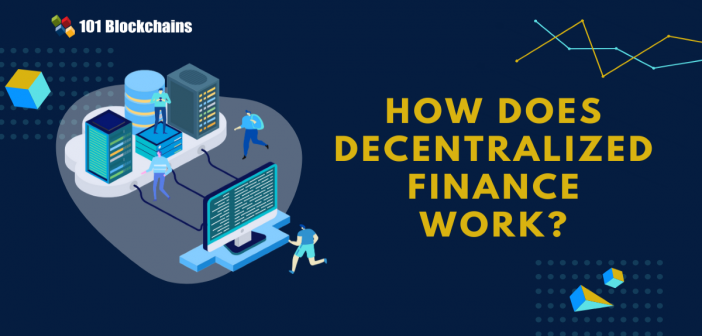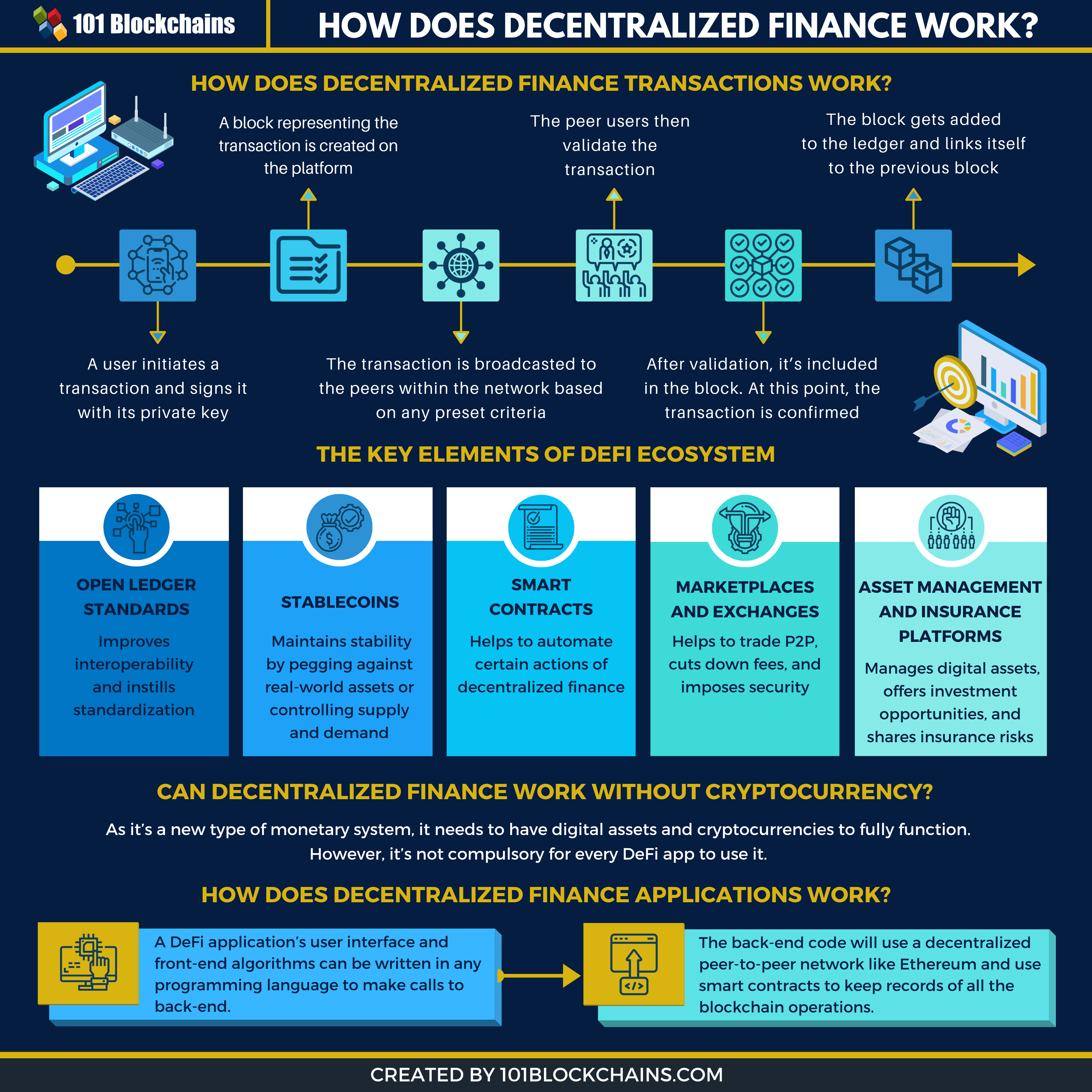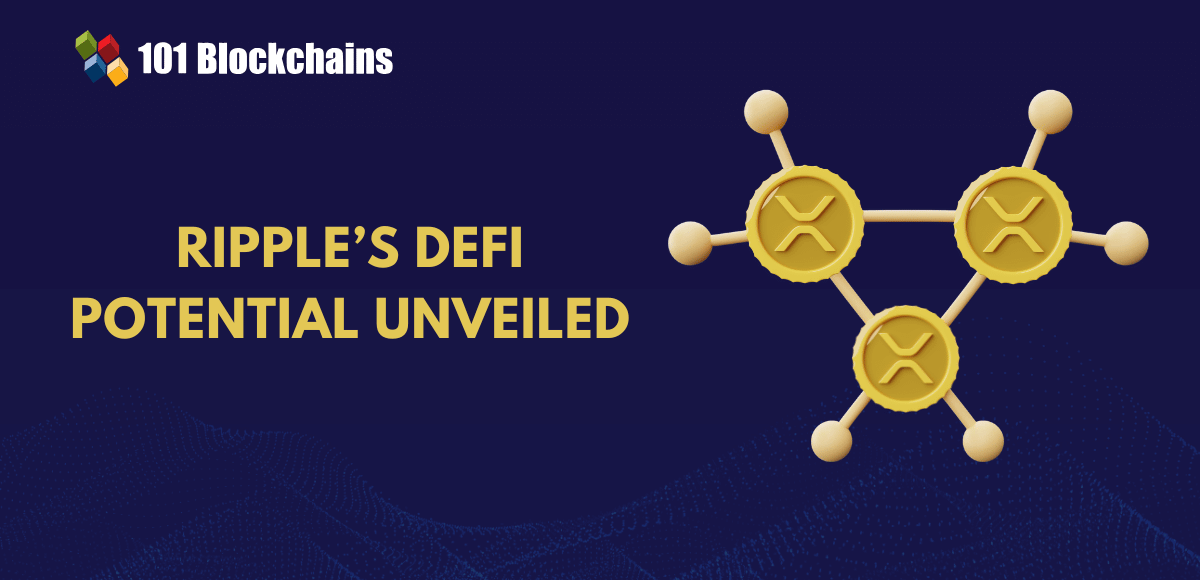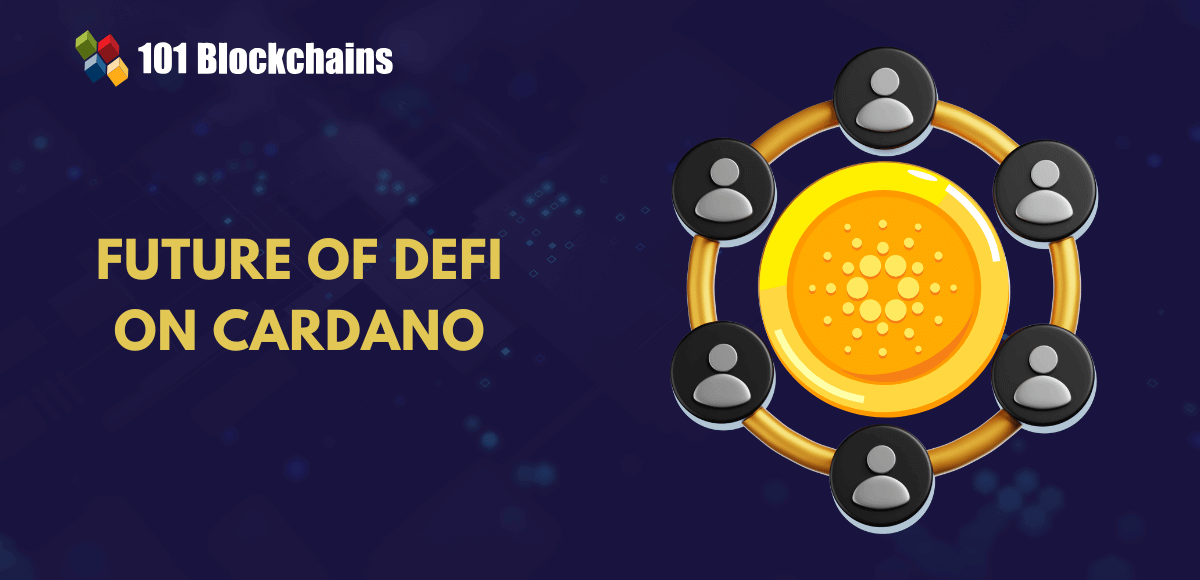Learn how blockchain truly works, master key definitions, and uncover what makes smart contracts so "smart." Dive into the fundamentals, gain valuable insights, and start your blockchain journey today!

- Decentralized Finance
Hasib Anwar
- on October 22, 2020
How Does Decentralized Finance Work?
DeFi, also known as decentralized finance, is one of the fastest-growing sectors within the blockchain industry. On the one hand, cryptocurrencies are giving us an alternative to using government-backed money. On the other hand, decentralized finance is creating new financial instruments that don’t need centralized institutions. But how does decentralized finance work? Let’s find out right now!
Although compared to the global economy, the whole spectrum of DeFi is still small, yet we are seeing rapid growth in 2020. In January 2019, $278.75M value was locked in the DeFi economy. However, by Jan 2020, that increased to $676.24M. More so, it reached $1B by June 2020 and continued to grow within July, going up to $3.95B. Now, in October, it’s hitting $11.2B, which is a massive amount of value.
This growth is showing how massive DeFi is going to become, and even though it’s still a small sector, many enterprises are highly interested in it. But still, many are not quite familiar with what is DeFi or how does decentralized finance works.
So, I’ll explain how decentralized finance can work in our centralized economy and what you should expect from it. Beginners can use this guide to understand more about the decentralized finance ecosystem.
Want to know more about DeFi? Enroll Now: Introduction to DeFi Course
How Does Decentralized Finance Work?
Before I explain the process of how decentralized finance can work, let’s check out some important features of this technology. In reality, decentralized finance uses public blockchains instead of private or federated ones.
So, more or less, these applications replicate the features or working process of public blockchains.
Basically, in the DeFi blockchain, you will see a ledger system that will keep tabs on all the different types of data exchanges that happens on the network. Actually, these data exchanges are ‘transactions’ in the blockchain network. Once these are verified, they get added to the ledger and called a block.
DeFi applications use a different type of distributed network to make sure that all the transactions within the system are on point and within peers only. Furthermore, once the network verifies a blockchain and adds it up to the ledger, no other peer can change or delete that.
Build your identity as a certified blockchain expert with 101 Blockchains’ Blockchain Certifications designed to provide enhanced career prospects.
The Working Process
DeFi blockchain makes sure that the process is secured by using “keys.” In this technology, when you will use a set of encrypted keys, you will get a unique identification that no one can get access to. Usually, this key pair includes a public and private key.
In reality, this process of using key pairs to encrypt information is called “asymmetric cryptography,” and it’s widely popular in the blockchain space.
Basically, here, other peers can see or use your public key to find you on the system. On the other hand, using your private key, you can authorize your transactions or any type of action. So, you will need a private key to perform certain actions on the DeFi blockchain network.
Although, some decentralized finance applications work differently where you may perform actions with KYC protocols.
As there are cryptocurrencies involved, so your public key will more likely work as your digital wallet. So, using your private key, you can buy, sell, or even send cryptocurrencies. This is why you really need to keep it safe.
So, for sending a transaction, you’ll have to authorize it with your private key. Once you do it, the system will create a block representing the transaction and notify the system for others to verify. After that, when others verify that it’s a valid request, then it will execute your transaction request and add the block to the ledger.
Furthermore, all the block gets a unique id and time frame that prevents any kind of malicious activity.
In DeFi, you will get pseudo-anonymous addresses. So, basically, no one can see your name, but they can see your address, which will contain random numbers and letters.
Want to explore in-depth about DeFi protocol and its use cases? Enroll in Decentralized Finance (Defi) Course- Intermediate Level Now!
How Secure Is Decentralized Finance?
Well, DeFi applications aren’t completely secure. In reality, no system can offer you 100% security. However, DeFi ensures that it offers a far more advanced security system compared to traditional monetary systems.
In reality, hacking these applications is highly difficult and quite tricky. As the system is distributed, cyber-criminals have to hack every single device using the application. This takes up a lot of resources and, in the end, not worth the effort.
But there are risks if a DeFi application is rolled out with an underlying bug or loophole. Just for this type of risk, many aren’t sure whether it’s a good idea to use the DeFi instead of CeFi.
Anyhow, just like any technology, DeFi just only started its journey and still has a long road ahead. But if we compare DeFi vs. CeFi, DeFi will surely take the win even with all the flaws.
Want to explore an in-depth understanding of security threats in DeFi projects? Enroll in DeFi Security Fundamentals Course Now!

Key Elements of the DeFi Ecosystem and How They Function
Let’s go through the key elements of DeFi to learn about how each of these works together to make up the ecosystem. In reality, every single element comes with its share of properties. So, it’s necessary to understand how these functions.
Basically, at the very core, you will see five elements –
- Open Ledger Standards
- Stablecoins
- Smart Contracts
- Marketplaces and Exchanges
- Asset Management and Insurance Platforms
Open Ledger Standards
Most of the decentralized finance companies use open ledger standards when they develop a new kind of DeFi application. This ensures that these applications have interoperability. So, without using common standards, decentralized applications won’t be compatible with one another.
Another great fact is that, without open-source standards, companies can’t use common standards as well. However, as most of the application is built upon Ethereum, it’s evident that these applications will have similar standards.
Also, these standards help lending platforms to offer more flexibility when it comes to digital assets.
Also, the use of public blockchains comes with its own set of benefits such as –
- Permissionless network
- Interoperability
- Transparency
- Immutability
- Faster transactions
Smart Contracts
Smart contracts are a crucial part of the DeFi ecosystem. In reality, smart contracts help to automate the process of decentralized finance. Smart contracts can automate anything from borrowing and lending to insurance claims.
Almost every single DeFi application uses smart contracts to facilitate its features. More so, the best part is that smart contracts don’t need any middleman, so there are no intermediary fees. Using smart contracts is easier, faster, and secure compared to traditional contracts.
But there are also risks in DeFi when they use smart contracts to facilitate actions.
Curious to understand the complete smart contract development lifecycle? Enroll in Smart Contracts Development Course Now!
Stablecoins
Another core element of DeFi is the stablecoins. Decentralized finance companies are trying to increase the usage of stablecoins instead of cryptocurrencies. Usually, the typical cryptos are quite volatile, and using them in DeFi can imbalance the nature of the financial system.
Anyhow, stablecoins are actually pegged against real-world currencies or assets. In reality, this process makes it more stable compared to typical cryptos. In any case, these are designed to remain stable even though the prices of the cryptos keeps changing.
Practically, there are four kinds of stablecoins. These are –
- Fiat-Collateralized
- Crypto-Collateralized
- Commodity-Collateralized
- Non-Collateralized
Want to learn the basic and advanced concepts of Stablecoin? Enroll in our Stablecoin Fundamentals Course Now!
Fiat-Collateralized
These are mainly pegged against fiat money, such as USD. In reality, these are more popular in the DeFi space compared to other stablecoins. Also, these are mainly pegged as a 1:1 ratio to fiat currency to make it more stable and less volatile.
Therefore, you will need to enforce better regulations to make it more popular than fiat money. The issue is fiat currecny backs these so they are somewhat centralized. So, the primary feature of DeFi directly clashes with this element.
Crypto-Collateralized
These stablecoins are pegged against a cryptocurrency. However, you may think that this will increase volatility instead of decreasing it. But these stablecoins aren’t pegged in a 1:1 ration like fiat-collateralized stablecoins.
To reduce the volatile nature, these are often over-collateralized. So, when the prices change, the stablecoin can absorb the fluctuations. Also, these stablecoins are more decentralized as they are backed by cryptos. So, the trustless, transparency and security also remain here.
Commodity-Collateralized
Commodity-collateralized is a type of stablecoin that are backed by commodities such as gold or silver. I guess the most common commodity is gold. But you can find stablecoins backed by real estate, oil, or even other precious metals.
So, the owners of these stablecoins will actually hold a tangible asset with existence in the real-world. This is something other cryptocurrencies can’t offer. People tend to hold on to these coins as, over time, these can increase the incentive for them.
Non-Collateralized
No asset backs up these coins. In reality, it may seem a bit contradictory to stablecoins principles; however, it works. Just like the US dollar, if people believe in their value, it can still maintain its stability. However, centralized authority governs these to keep the supply and demand balanced for ensuring stable value.
Want to know more about stablecoins? Check out our comprehensive guide on stablecoins to learn more about it.
Marketplaces and Exchanges
Decentralized exchanges and open marketplaces are also a part of the DeFi ecosystem. In reality, decentralized exchanges ensure that users can trade digital assets without revealing their full identity. More so, these exchanges can save time, cut down fees, and impose security.
Marketplaces help to users to exchange assets or products directly without any issues. It really gives it a different kind of take on online marketplaces as you won’t have to depend on a third party to offer their platform to do so.
Also, some marketplaces also offer freelance gigs that can earn you money for your service.
Asset Management and Insurance Platforms
The DeFi ecosystem includes asset management, which also covers investment management as well. Using these platforms, users can manage their assets and get investment opportunities as well. Basically, these wallets help to interact with trading applications for transferring, buying, and selling digital assets.
Decentralized finance companies also offer insurance platforms for the betterment of users. In reality, the insurance industry needs a change because of the abundance of paperwork and false claims.
On the other hand, insurance claims take up too much time and cause a lot of hassles along the way. But insurance management platforms can streamline the process through smart contracts and use auditors to check an insurance claim’s authenticity.
Can Decentralized Finance Work Without Cryptocurrency?
It’s quite obvious that without cryptocurrencies decentralized finance ecosystem can’t work. As it’s a new type of monetary system, it needs to have digital assets and cryptocurrencies to fully function. However, even though most decentralized finance example use some kind of native token or asset, it’s not compulsory for every DeFi app to use it.
In reality, many DeFi applications don’t need cryptos. For example, infrastructure development tools such as Truffle or Ganache gives you a suite of tools. You can use these tools to develop solutions, but you won’t need cryptos to use the tools.
In reality, the ecosystem is vast, and while the ecosystem is dependent on cryptocurrencies, not all the elements are dependent on them.
More so, the digital asset industry varies greatly based on the type of application it is.
Want to become a Cryptocurrency expert? Enroll Now in Cryptocurrency Fundamentals Course
Cryptocurrencies May Fail
Well, cryptocurrencies have their own issues – they are volatile and unpredictable. So, basing a new monetary system on a volatile asset wouldn’t be a smart call.
Another important thing to note down is the increasing popularity of stablecoins. Stablecoins are also cryptocurrencies, but they are pegged against real-world fiat money. So, they can replace all the volatile nature of the cryptocurrencies.
To make it perfect, another type of financial system is quickly getting into the limelight – Central Bank Digital Currency (CBDC).
Here, the system uses blockchain technology, but it’s not fully decentralized. More so, it also introduces a digital version of the fiat money that we use. So, the control over the digital money will prevail, but it will ensure that the asset will not become volatile.
Therefore, it’s more like a hybrid version of decentralized finance technology. In the future, DeFi can take a turn to become this type of structure if it wants to replace the traditional monetary system. However, if DeFi manages to get rid of its flaws, it may truly retain its decentralized nature.
How Does Decentralized Finance Applications Work?
Almost all the decentralized finance applications leverage Ethereum to achieve the features of blockchain technology. In reality, Ethereum offers quasi-Turing Ethereum Virtual Machine (EVM), which is practically the sole reason for the rise of DeFi applications. Basically, a Turing machine can replicate, stimulate, and run any kind of algorithms.
More so, EVM is also the backbone of smart contracts, which is a compulsory component of DeFi. You can program any smart contracts or decentralized finance code for EVM and use the Ethereum network to execute it.
However, all the DeFi applications don’t necessarily need a blockchain network to run. In fact, there are applications that run on a special P2P network rather than on top of the blockchain.
DeFi applications are a part of a software that communicates with the blockchain that manages all the users’ state in the network. Furthermore, the interface of these applications is more similar to traditional mobile or web applications.
Decentralized finance can work by using smart contracts, which represents the core logic behind the applications. More so, smart contracts help to execute actions and manages the state of the blockchain.
The front-end of these applications is the user-interface, and the back-end contains the business logic. Anyhow, business logic uses one or more smart contracts to interact with the blockchain network. You can host the front-end on a decentralized storage network such as IPFS or Swarm.
But here, in the front-end, you will get a wallet that will help you communicate with the blockchain. Usually, this wallet will manage your blockchain address and cryptographic keys. Let’s take MetaMask as a decentralized finance app example.
You can use it as a browser extension or a mobile app that will let you interact with the blockchain and manage your assets.
Excited to learn the basic and advanced concepts of ethereum technology? Enroll Now in The Complete Ethereum Technology Course
Summarizing the Process
Here’s a summary of how decentralized finance applications work:
- A DeFi application’s user interface and front-end algorithms can be written in any programming language to make calls to back-end.
- The back-end code will use a decentralized peer-to-peer network like Ethereum and use smart contracts to keep records of all the blockchain operations.
- These applications are mostly open-source, so you can freely access the code and build on top of it. Therefore, no one can technically own the applications, and that’s why DeFi apps are called money Legos.
- The users of a DeFi application need to govern themselves as there is no central authority.
Concluding Thoughts
Decentralized finance is truly a unique take on our typical monetary system, and it can surely make a lot of differences. In reality, the ecosystem is vast and still rapidly growing. So, it’s only a matter of time that this technology will become widely accepted around the world.
Now that you know how decentralized finance can work from this guide, you can now try out these applications yourself. However, if you are more interested in developing these applications, I’ll recommend you check out our decentralized finance course.
Learners can get access to a vast amount of information from this guide, and it will go into more depth on how decentralized finance works. So, don’t waste any more time and take the first step towards your blockchain journey now!
*Disclaimer: The article should not be taken as, and is not intended to provide any investment advice. Claims made in this article do not constitute investment advice and should not be taken as such. Do your own research and make sure you read our full Disclaimer.



![30+ Best Decentralized Finance Applications [Updated] best decentralized finance (DeFi) applications](https://101blockchains.com/wp-content/uploads/2020/10/decentralized-finance-applications.png)

